Spatial Distribution of Fine Particulate Matter in Underground Passageways
Abstract
1. Introduction
2. Materials and Methods
2.1. Experimental Site Description
2.2. Measurements and Field Campaigns
2.2.1. Pedestrian Data
2.2.2. Meteorological Data
2.2.3. Contaminant Sampling
2.3. Numerical Model
2.3.1. Turbulence Model and Discrete Phase Model
2.3.2. Computational Domain and Mesh Discretization
2.3.3. Boundary Conditions
3. Results
3.1. Field Measurements
3.1.1. PM2.5 Concentration in Different Locations
3.1.2. Temporal and Spatial Characteristics of PM2.5 Concentration
3.2. Validation of the Numerical Model with Field Data
3.3. Effects of Ventilation Mode
3.4. Effects of Inlet Air Velocity
- v = 0.2 m/s: CPM2.5 = −0.702y + 84.894 (R2 =0.981, p < 0.01).
- v = 0.4 m/s: CPM2.5 = −0.323y + 40.903 (R2 =0.960, p < 0.01).
- v = 0.6 m/s: CPM2.5 = −0.215y + 26.901 (R2 =0.958, p < 0.01).
- v = 0.8 m/s: CPM2.5 = −0.161y + 20.574 (R2 =0.953, p < 0.01).
- v = 1.0 m/s: CPM2.5 = −0.123y + 16.097 (R2 =0.942, p < 0.01).
3.5. Effects of Entrance Position
4. Discussion
5. Conclusions
- (1)
- Although there are contaminants such as CO and VOC in the underground passageway, particle matter is the main pollutant. There is a strong correlation between PM2.5 and PM10, indicating their homology.
- (2)
- According to the comparison of pollutant concentration in different locations, it was found that ventilation is a major factor affecting the concentration of pollutants, in addition to the impact of pollution sources.
- (3)
- By exploring the temporal variation of PM2.5 concentration in the underground passageway, it was determined that the number of pedestrians also affects the concentration of pollutants. This also confirms that pedestrians are the main source of PM2.5 in underground passageways.
- (4)
- Several scenarios with additional entrance were built. Then, numerical analysis was done by changing the inlet air velocity. The results show that the concentration of PM2.5 in the underground passageway decreases with the increase of inlet wind speed. Therefore, in practice, it is possible to increase the intake volume and reduce the pollution in the underground passageway by keeping the entrance unblocked and having the entrance in an open area.
- (5)
- Attempts were made to find the optimal position of additional entrance by changing its position in simulation. Results show that vents should not be built at backward positions, and should be built for each section of the zigzag underground passageway.
Author Contributions
Funding
Acknowledgments
Conflicts of Interest
References
- Web Page of the News “The Construction of Underground Engineering in China Ranks the Top of the World”. Available online: http://www.xinhuanet.com/finance/2015-04/10/c_127674925.htm (accessed on 7 July 2018).
- China’s Urban Rail Transit 2016 Annual Statistical and Analytical Report Released in Full. Available online: http://wcm.cnautonews.com/pub/gdjt/hyxw/201703/t20170331_530367.htm (accessed on 7 July 2018).
- Nishi, J.; Tanaka, T.; Seiki, T.; Ito, H.; Okuyama, K. Estimation of the value of the internal and external environment in underground space use. Tunn. Undergr. Space Technol. 2000, 15, 79–89. [Google Scholar] [CrossRef]
- El-Fadel, M.; Hashisho, Z. Vehicular emissions and air quality assessment in roadway tunnels: The Salim Slam tunnel. Transp. Res. Part D 2000, 5, 355–372. [Google Scholar] [CrossRef]
- Moreno, T.; Pérez, N.; Reche, C.; Martins, V.; Miguel, E.D.; Capdevila, M.; Centelles, S.; Minguillón, M.C.; Amato, F.; Alastuey, A. Subway platform air quality: Assessing the influences of tunnel ventilation, train piston effect and station design. Atmos. Environ. 2014, 92, 461–468. [Google Scholar] [CrossRef]
- Cui, G.; Zhou, L.; Dearing, J. Granulometric and magnetic properties of deposited particles in the Beijing subway and the implications for air quality management. Sci. Total Environ. 2016, 568, 1059–1068. [Google Scholar] [CrossRef] [PubMed]
- Zhao, Y.; Song, X.; Wang, Y.; Zhao, J.; Zhu, K. Seasonal patterns of PM10, PM2.5, and PM1.0 concentrations in a naturally ventilated residential underground garage. Build. Environ. 2017, 124, 294–314. [Google Scholar] [CrossRef]
- Papakonstantinou, K.; Chaloulakou, A.; Duci, A.; Vlachakis, N.; Markatos, N. Air quality in an underground garage: Computational and experimental investigation of ventilation effectiveness. Energy Build. 2003, 35, 933–940. [Google Scholar] [CrossRef]
- Shang, Y.; Li, B.; Baldwin, A.N.; Ding, Y.; Yu, W.; Cheng, L. Investigation of indoor air quality in shopping malls during summer in Western China using subjective survey and field measurement. Build. Environ. 2016, 108, 1–11. [Google Scholar] [CrossRef]
- Thatcher, T.L.; Layton, D.W. Deposition, resuspension, and penetration of particles within a residence. Atmos. Environ. 1995, 29, 1487–1497. [Google Scholar] [CrossRef]
- Chatoutsidou, S.E.; Ondráček, J.; Tesar, O.; Tørseth, K.; Zdimal, V.; Lazaridis, M. Indoor/Outdoor particulate matter number and mass concentration in modern offices. Build. Environ. 2015, 92, 462–474. [Google Scholar] [CrossRef]
- Serfozo, N.; Chatoutsidou, S.E.; Lazaridis, M. The effect of particle resuspension during walking activity to PM 10 mass and number concentrations in an indoor microenvironment. Build. Environ. 2014, 82, 180–189. [Google Scholar] [CrossRef]
- Goldasteh, I. CFD Simulation of Particle Transport and Dispersion in Indoor Environment by Human Walking. In Proceedings of the ASME 2012 Fluids Engineering Division Summer Meeting Collocated with the ASME 2012 Heat Transfer Summer Conference and the ASME 2012 International Conference on Nanochannels, Microchannels, and Minichannels, Rio Grande, Puerto Rico, 8–12 July 2012; pp. 267–272. [Google Scholar] [CrossRef]
- Kopperud, R.J.; Ferro, A.R.; Hildemann, L.M. Outdoor versus indoor contributions to indoor particulate matter (PM) determined by mass balance methods. J. Air Waste Manag. Assoc. 2004, 54, 1188–1196. [Google Scholar] [CrossRef] [PubMed]
- Zhang, X.; Ahmadi, G.; Qian, J.; Ferro, A. Particle Detachment, Resuspension and Transport Due to Human Walking in Indoor Environments. J. Adhes. Sci. Technol. 2008, 22, 591–621. [Google Scholar] [CrossRef]
- Ferro, A.R.; Kopperud, R.J.; Hildemann, L.M. Source strengths for indoor human activities that resuspend particulate matter. Environ. Sci. Technol. 2004, 38, 1759–1764. [Google Scholar] [CrossRef] [PubMed]
- Khalil, E.E.; Gomaa, S. Design of the Ventilation System in an Underground Car Park:The Effect of Jet Fans Configurations. In Proceedings of the International Energy Conversion Engineering Conference, Orlando, FL, USA, 27–29 July 2015. [Google Scholar] [CrossRef]
- Kim, J.Y.; Kim, K.Y. Effects of vent shaft location on the ventilation performance in a subway tunnel. J. Wind Eng. Ind. Aerodyn. 2009, 97, 174–179. [Google Scholar] [CrossRef]
- News on Passenger Flow in Three Railway Stations of Shanghai during the Spring Festival of 2018. Available online: http://baijiahao.baidu.com/s?id=1592356831463419296&wfr=spider&for=pc (accessed on 7 July 2018).
- Domingo, J.; Barbero, R.; Iranzo, A.; Cuadra, D.; Servert, J.; Marcos, M.A. Analysis and optimization of ventilation systems for an underground transport interchange building under regular and emergency scenarios. Tunn. Undergr. Space Technol. 2011, 26, 179–188. [Google Scholar] [CrossRef]
- Nielsen, P.V. Flow in Air Conditioned Rooms. Ph.D. Thesis, Technical University of Denmark, Lyngby, Denmark, 1974. [Google Scholar]
- Gorman, A.D. The Flow Properties of Rooms with Small Ventilation Openings. J. Fluids Eng. 1980, 102, 316–323. [Google Scholar] [CrossRef]
- Sakamoto, Y.; Matsuo, Y. Numerical predictions of three-dimensional flow in a ventilated room using turbulence models. Appl. Math. Model. 1980, 4, 67–72. [Google Scholar] [CrossRef]
- Wang, Y.; Zhou, Y.; Zuo, J.; Rameezdeen, R. A Computational Fluid Dynamic (CFD) Simulation of PM10Dispersion Caused by Rail Transit Construction Activity: A Real Urban Street Canyon Model. Int. J. Environ. Res. Public Health 2018, 15, 482. [Google Scholar] [CrossRef] [PubMed]
- Mei, D.; Deng, Q.; Wen, M.; Fang, Z. Evaluating Dust Particle Transport Performance within Urban Street Canyons with Different Building Heights. Aerosol Air Qual. Res. 2016, 16, 1483–1496. [Google Scholar] [CrossRef]
- Sale Page of the SDS Jet Fan. Available online: https://b2b.hc360.com/supplyself/82824825477.html (accessed on 30 May 2018).
- Buccolieri, R.; Gromke, C.; Di, S.S.; Ruck, B. Aerodynamic effects of trees on pollutant concentration in street canyons. Sci. Total Environ. 2009, 407, 5247–5256. [Google Scholar] [CrossRef] [PubMed]
- Gallagher, J.; Gill, L.W.; Mcnabola, A. Numerical modelling of the passive control of air pollution in asymmetrical urban street canyons using refined mesh discretization schemes. Build. Environ. 2012, 56, 232–240. [Google Scholar] [CrossRef]
- Eisner, A.D.; Rosati, J.; Wiener, R. Experimental and theoretical investigation of particle-laden airflow under a prosthetic mechanical foot in motion. Build. Environ. 2010, 45, 878–886. [Google Scholar] [CrossRef]

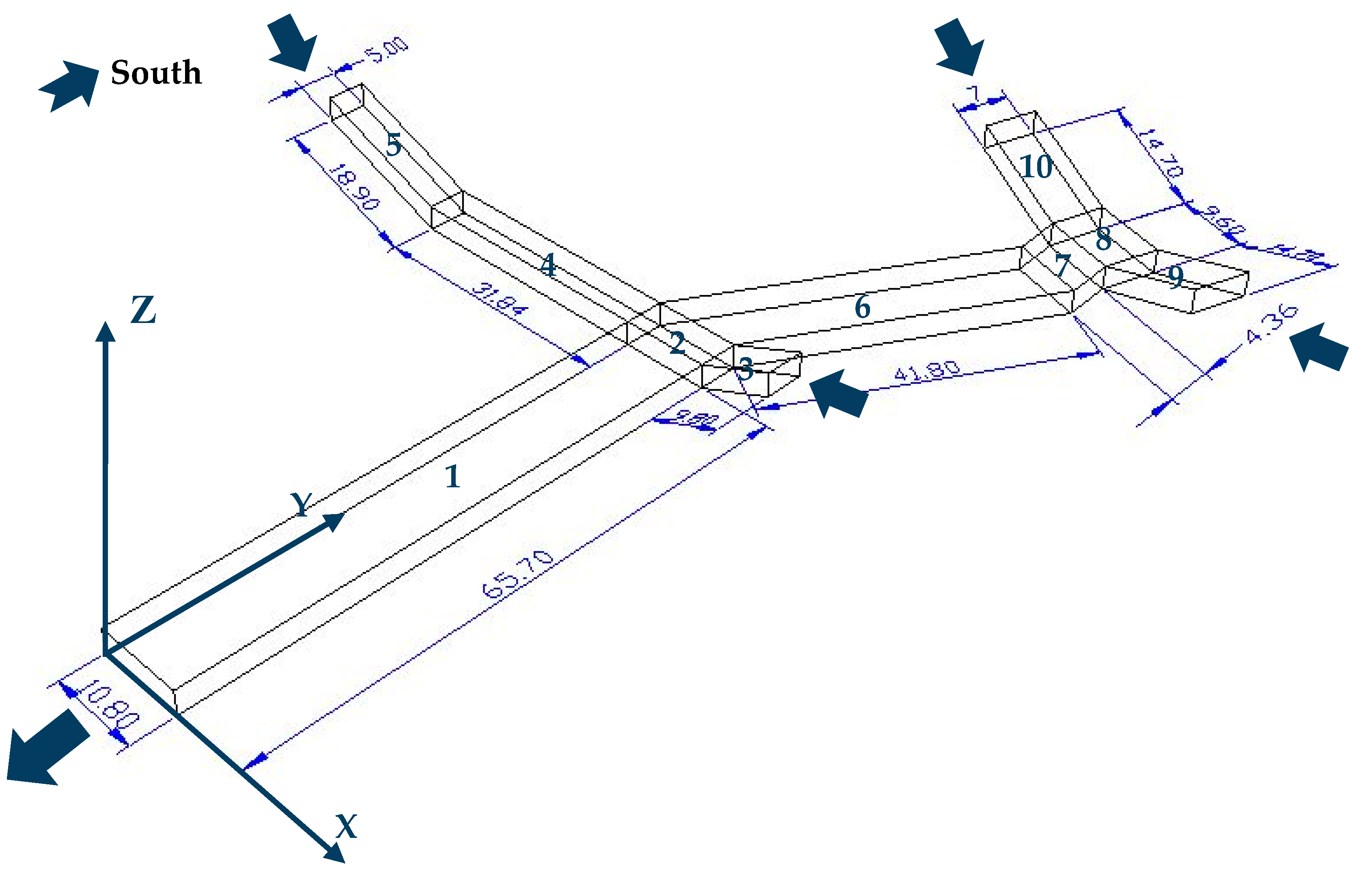


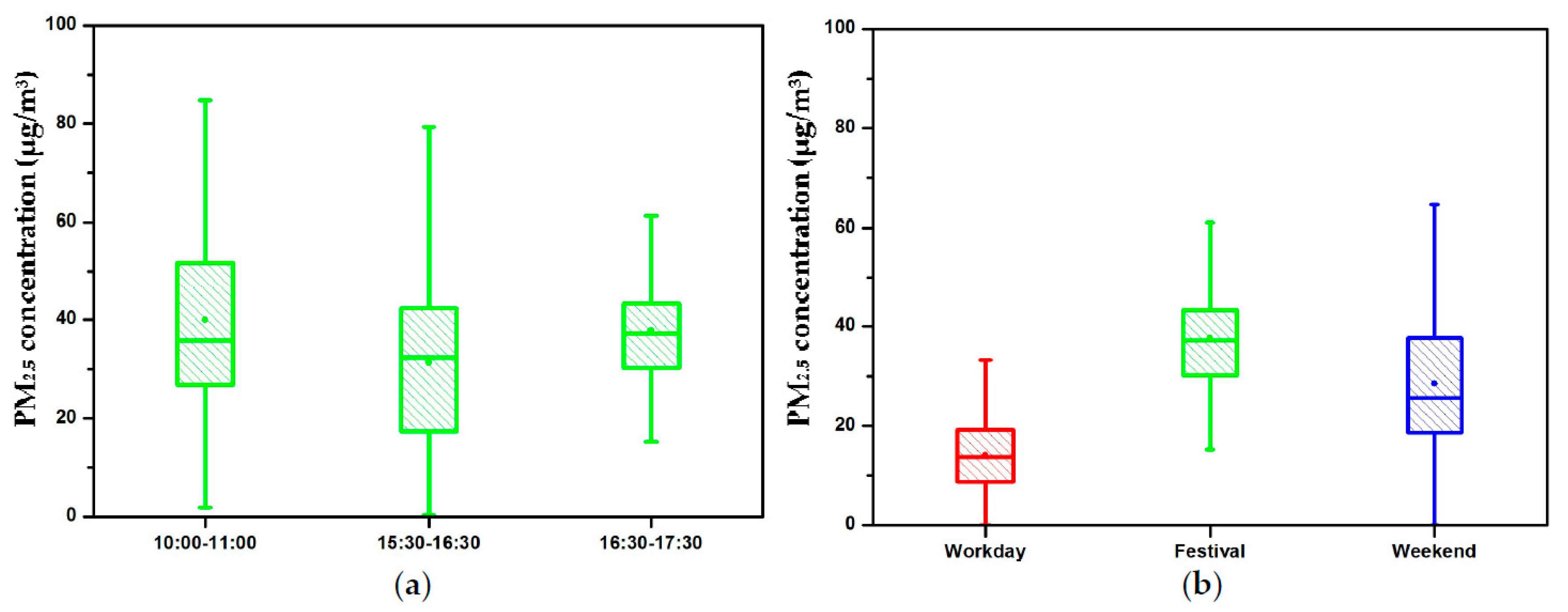

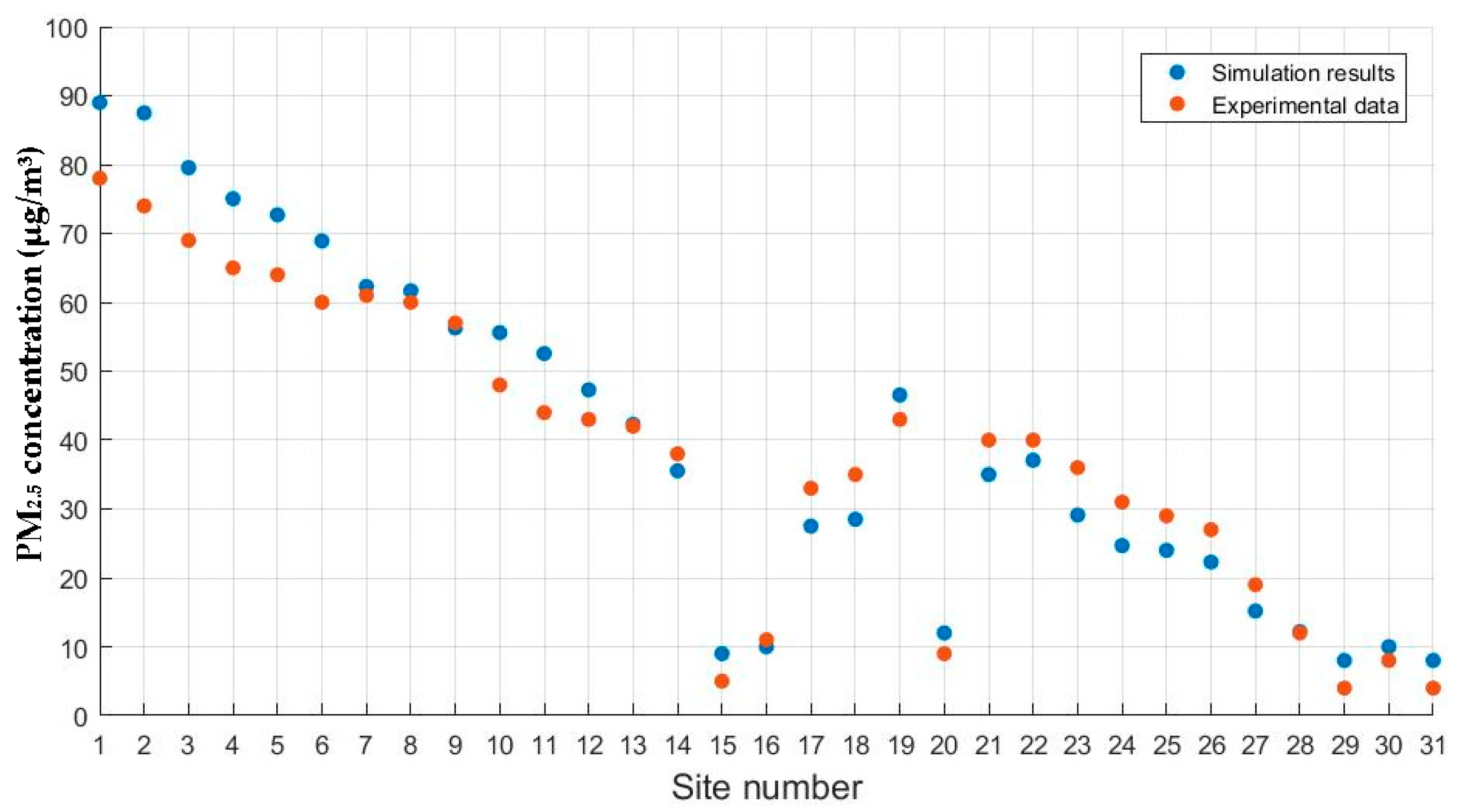

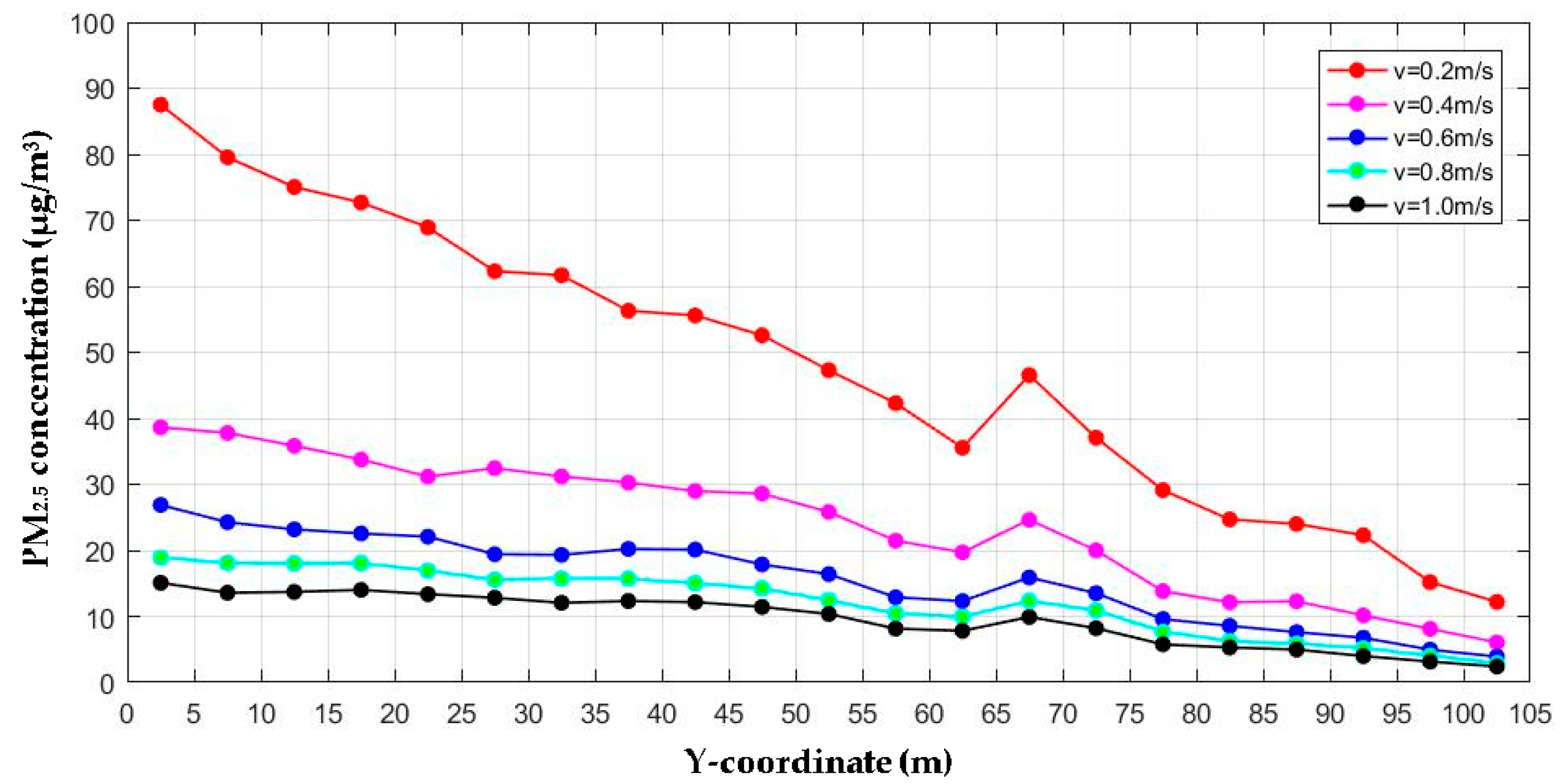
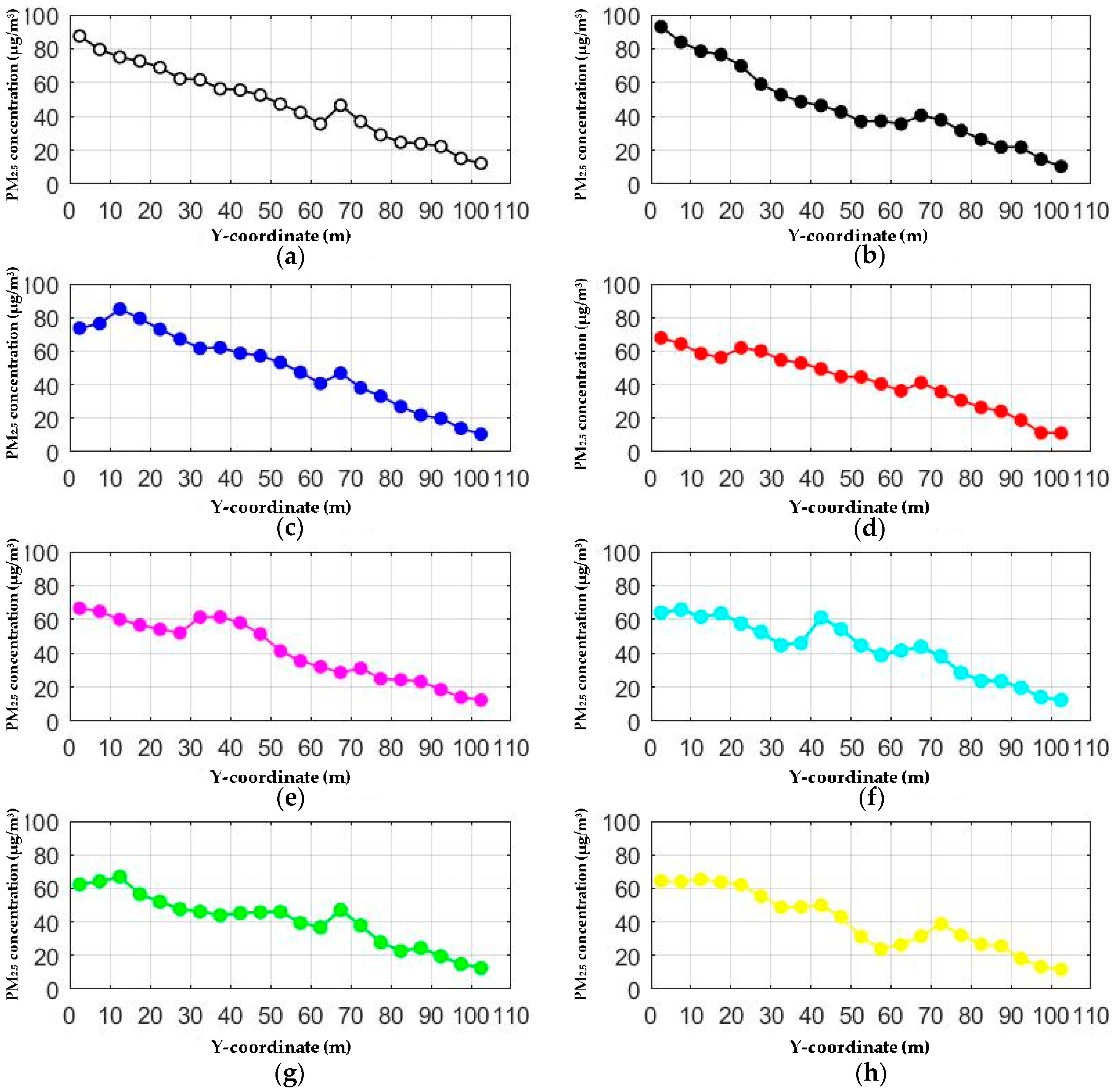

| Site Number 1 | X-Coordinate ( m) | Y-Coordinate (m) |
|---|---|---|
| 1 | 5.4 | 0 |
| 2 | 5.4 | 5.0 |
| 3 | 5.4 | 10.0 |
| 4 | 5.4 | 15.0 |
| 5 | 5.4 | 20.0 |
| 6 | 5.4 | 25.0 |
| 7 | 5.4 | 30.0 |
| 8 | 5.4 | 35.0 |
| 9 | 5.4 | 40.0 |
| 10 | 5.4 | 45.0 |
| 11 | 5.4 | 50.0 |
| 12 | 5.4 | 55.0 |
| 13 | 5.4 | 60.0 |
| 14 | 5.4 | 65.0 |
| 15–20 | −44.5, −38.0, −21.5, −10.5, 5.4, 15.0 | 68.5 |
| 21 | 5.4 | 70.0 |
| 22 | 7.5 | 75.0 |
| 23 | 10.5 | 80.0 |
| 24 | 13.5 | 85.0 |
| 25 | 16.5 | 90.0 |
| 26 | 19.5 | 95.0 |
| 27 | 22.0 | 100.0 |
| 28 | 25.8 | 107.0 |
| 29 | 39.5 | 108.5 |
| 30 | 27.5 | 112.0 |
| 31 | 15.5 | 116.0 |
| Components | Condition Type | Value |
|---|---|---|
| staircase entrances | velocity inlet | v = 0.20 m/s |
| exit | pressure outlet | relative pressure p = 0 |
| ceiling | stationary wall | roughness constant = 0.50 |
| wall | stationary wall | roughness constant = 0.50 |
| pedestrian | stationary wall | roughness constant = 0.50 |
| floor-segment 1 and 2 | stationary wall | roughness constant = 0.50 |
| injection source | v = 0.10 m/s, total flow rate = 770 μg/s | |
| floor-segment 3 | stationary wall | roughness constant = 0.50 |
| injection source | v = 0.10 m/s, flow rate = 21 μg/s | |
| floor-segment 4 | stationary wall | roughness constant = 0.50 |
| injection source | v = 0.10 m/s, flow rate = 91 μg/s | |
| floor-segment 5 | stationary wall | roughness constant = 0.50 |
| injection source | v = 0.10 m/s, flow rate = 35 μg/s | |
| floor-segment 6 | stationary wall | roughness constant = 0.50 |
| injection source | v = 0.10 m/s, flow rate = 322 μg/s | |
| floor-segment 7, 8, 9 and 10 | stationary wall | roughness constant = 0.50 |
| injection source | v = 0.10 m/s, total flow rate = 87.5 μg/s | |
| out surface of jet fan | stationary wall | roughness constant = 0.50 |
| inlet and outlet of jet fan | velocity inlet | vin = −16.10 m/s, vout = 16.10 m/s |
| Contaminants | Min. | Max. | Mean. | S.D. | L.B. | U.B |
|---|---|---|---|---|---|---|
| CO (ppm) | 2.58 | 2.62 | 2.60 | 0.01 | 2.59 | 2.60 |
| VOC (ppb) | 76 | 92 | 86 | 4.23 | 85 | 87 |
| PM2.5 (μg/m3) | 52 | 96 | 71 | 11.94 | 69 | 73 |
| PM10 (μg/m3) | 62 | 137 | 96 | 22.21 | 92 | 100 |
| Site | PM2.5 (μg/m3) | |||||
|---|---|---|---|---|---|---|
| Min. | Max. | Mean. | S.D. | L.B.1 | U.B.2 | |
| Shopping malls | 20 | 36 | 26 | 3.53 | 25 | 27 |
| South Square | 22 | 50 | 37 | 5.02 | 36 | 38 |
| Underground open-air section | 31 | 74 | 44 | 7.71 | 43 | 46 |
| Metro line 3 platform | 28 | 48 | 37 | 4.63 | 36 | 38 |
| Metro line 1 platform | 34 | 87 | 46 | 9.98 | 45 | 49 |
| Metro transfer corridor | 35 | 54 | 43 | 4.78 | 42 | 44 |
| Railway transfer corridor | 34 | 60 | 45 | 6.40 | 44 | 46 |
| Pedestrian passageway in the south | 58 | 108 | 88 | 11.63 | 85 | 90 |
| Pedestrian passageway in the north | 30 | 86 | 45 | 8.58 | 43 | 48 |
| Small restaurants | 31 | 111 | 53 | 14.97 | 51 | 56 |
© 2018 by the authors. Licensee MDPI, Basel, Switzerland. This article is an open access article distributed under the terms and conditions of the Creative Commons Attribution (CC BY) license (http://creativecommons.org/licenses/by/4.0/).
Share and Cite
Song, X.-Y.; Lu, Q.-C.; Peng, Z.-R. Spatial Distribution of Fine Particulate Matter in Underground Passageways. Int. J. Environ. Res. Public Health 2018, 15, 1574. https://doi.org/10.3390/ijerph15081574
Song X-Y, Lu Q-C, Peng Z-R. Spatial Distribution of Fine Particulate Matter in Underground Passageways. International Journal of Environmental Research and Public Health. 2018; 15(8):1574. https://doi.org/10.3390/ijerph15081574
Chicago/Turabian StyleSong, Xin-Yi, Qing-Chang Lu, and Zhong-Ren Peng. 2018. "Spatial Distribution of Fine Particulate Matter in Underground Passageways" International Journal of Environmental Research and Public Health 15, no. 8: 1574. https://doi.org/10.3390/ijerph15081574
APA StyleSong, X.-Y., Lu, Q.-C., & Peng, Z.-R. (2018). Spatial Distribution of Fine Particulate Matter in Underground Passageways. International Journal of Environmental Research and Public Health, 15(8), 1574. https://doi.org/10.3390/ijerph15081574




